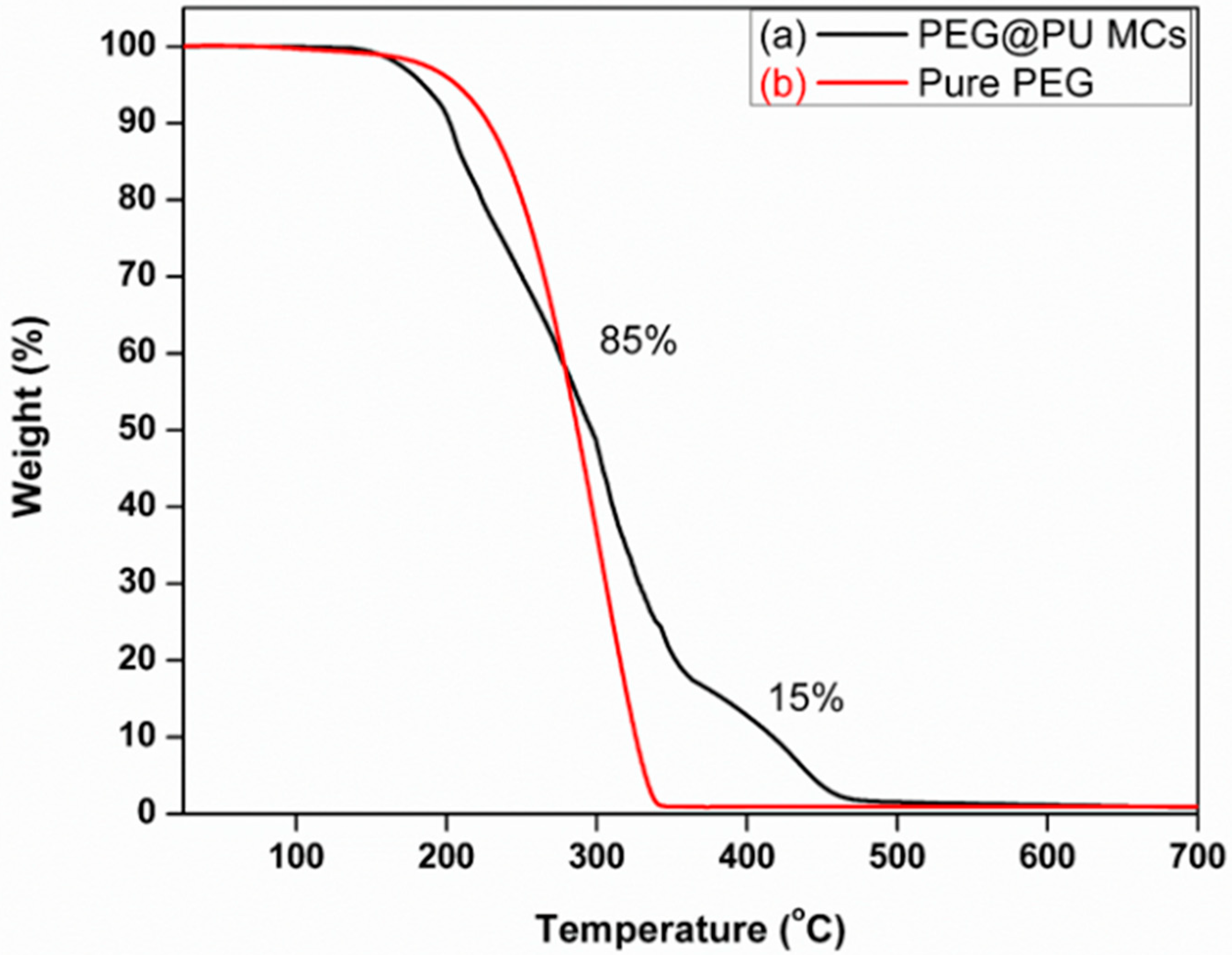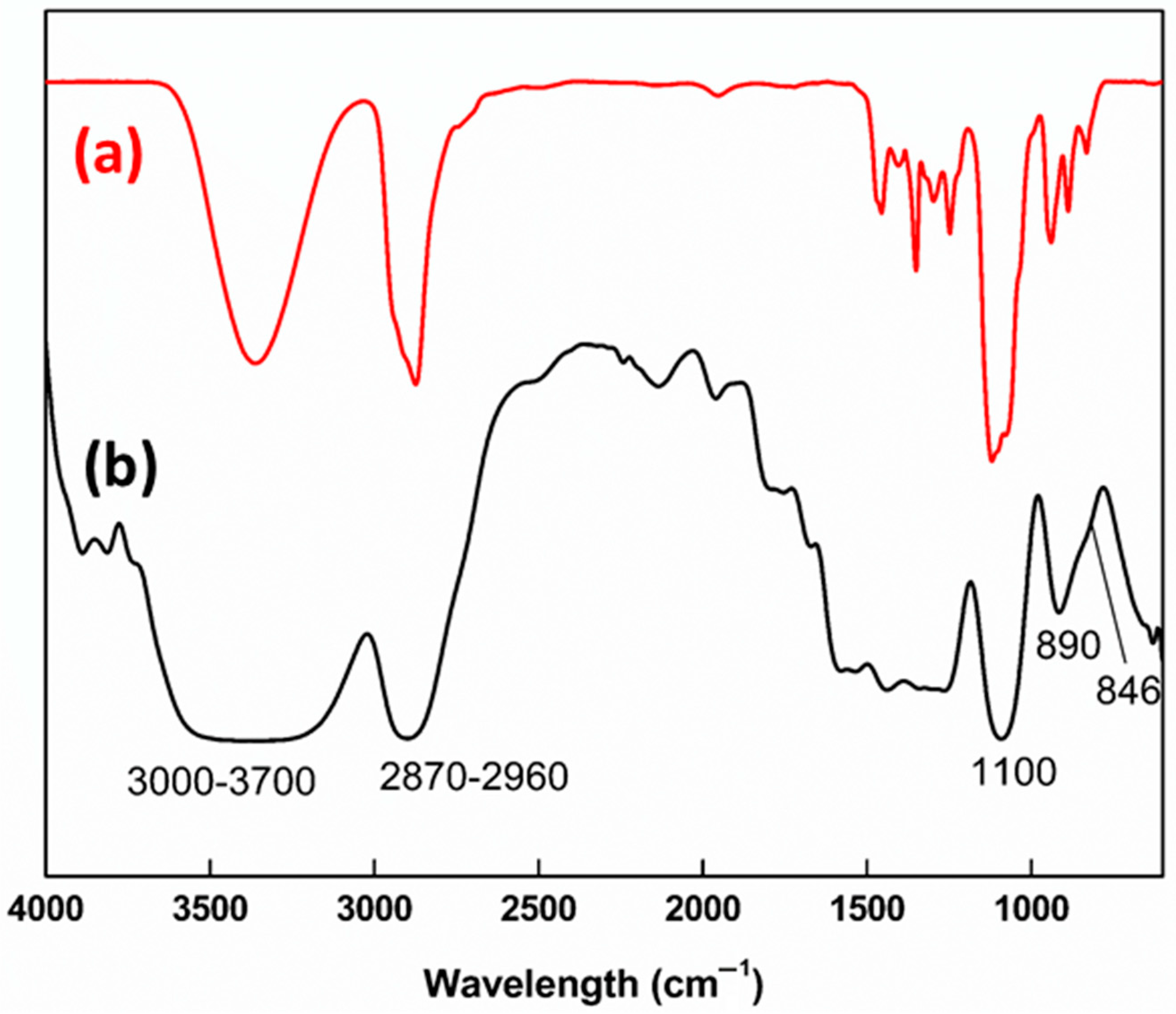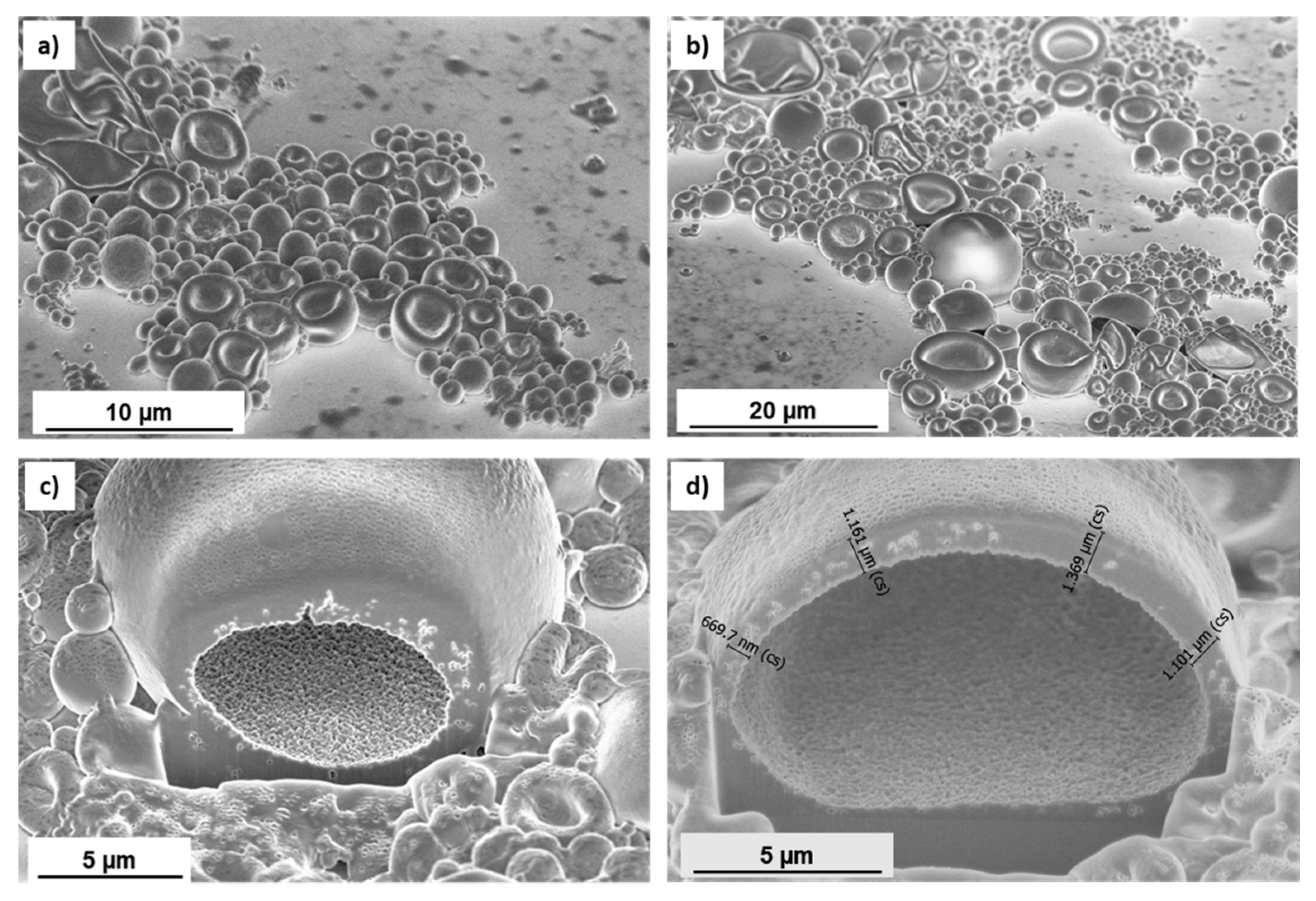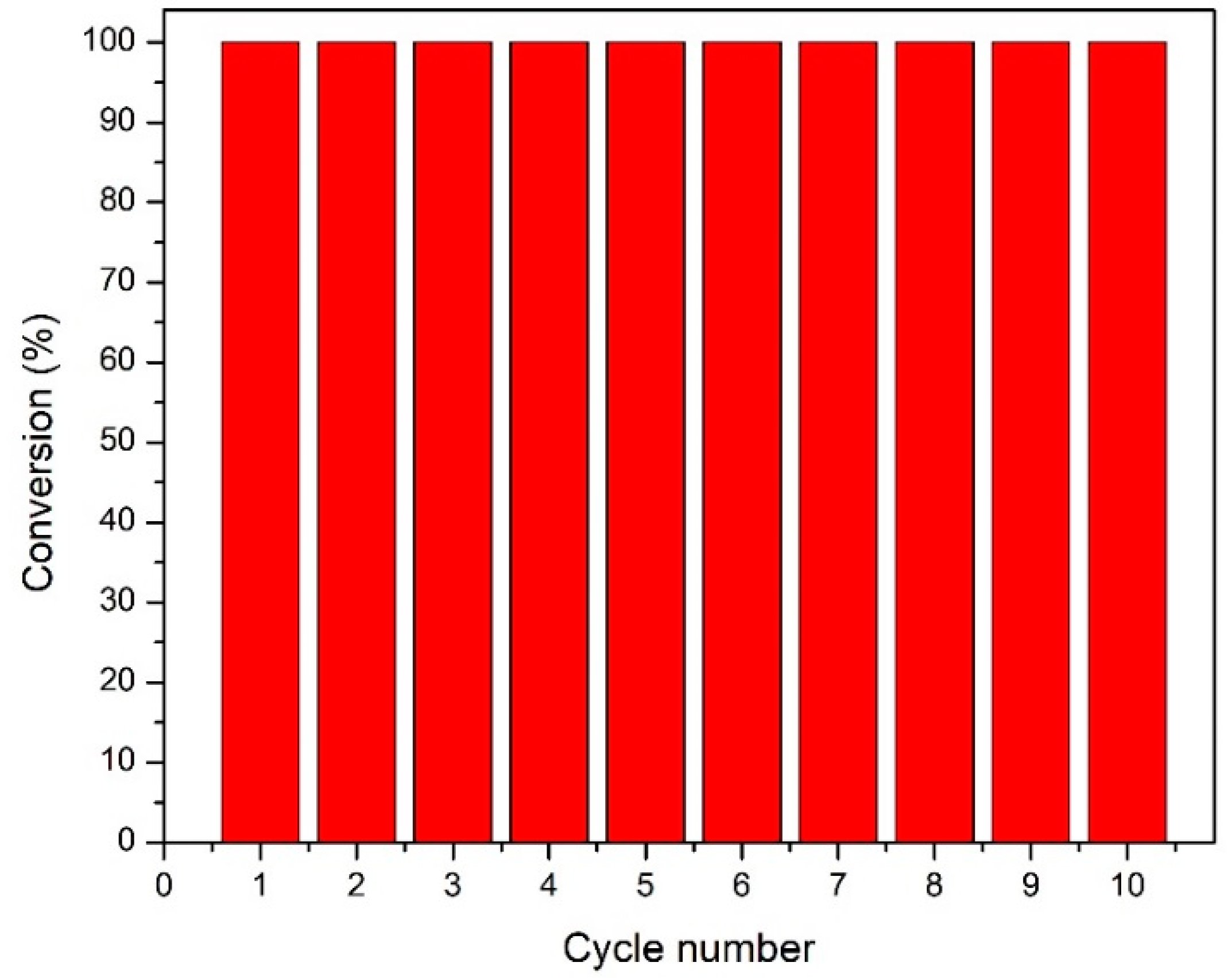Preparation of Poly(ethylene glycol)@Polyurea Microcapsules Using Oil/Oil Emulsions and Their Application as Microreactors
Abstract
:1. Introduction
2. Materials and Methods
2.1. Materials
2.2. Instrumentation
2.3. The Procedure for Preparing the PdNPs/PEG200 Polar Phase
2.4. General Procedure for Preparing the PdNPs/PEG200@PU Microreactors
2.5. General Procedure for the Hydrogenation Reaction
3. Results and Discussion
3.1. Synthesis and Optimization of the PEG200@PU MCs
3.2. Characterization of the PdNPs/PEG200@PU MCs
3.3. Evaluation of the Catalytic Performance
4. Conclusions
Supplementary Materials
Author Contributions
Funding
Institutional Review Board Statement
Informed Consent Statement
Data Availability Statement
Acknowledgments
Conflicts of Interest
References
- Benaglia, M. Recoverable and Recyclable Catalysts; John Wiley & Sons Ltd.: Hoboken, NJ, USA, 2009. [Google Scholar]
- Hagen, J. Industrial Catalysis: A Practical Approach, 3rd ed.; Wiley-VCH Verlag GmbH & Co. KGaA: Weinheim, Germany, 2015. [Google Scholar]
- Cole-Hamilton, D.J. Homogeneous Catalysis—New Approaches to Catalyst Separation, Recovery, and Recycling. Science 2003, 299, 1702. [Google Scholar] [CrossRef]
- van Leeuwen, P.W.N.M. Homogeneous Catalysis: Understanding the Art; Springer: Berlin/Heidelberg, Germany, 2004. [Google Scholar]
- Friend, C.M.; Xu, B. Heterogeneous catalysis: A central science for a sustainable future. Acc. Chem. Res. 2017, 50, 517–521. [Google Scholar] [CrossRef]
- Schlögl, R. Heterogeneous catalysis. Angew. Chem. Int. Ed. 2015, 54, 3465–3520. [Google Scholar] [CrossRef] [Green Version]
- Yang, X.; Wang, Y.; Bai, R.; Ma, H.; Wang, W.; Sun, H.; Dong, Y.; Qu, F.; Tang, Q.; Guo, T.; et al. Pickering emulsion-enhanced interfacial biocatalysis: Tailored alginate microparticles act as particulate emulsifier and enzyme carrier. Green Chem. 2019, 21, 2229–2233. [Google Scholar] [CrossRef]
- Zhang, Y.; Zhang, M.; Yang, H. Tuning biphasic catalysis reaction with a pickering emulsion strategy exemplified by selective hydrogenation of benzene. ChemCatChem 2018, 10, 5224–5230. [Google Scholar] [CrossRef]
- Chen, Z.; Vorobyeva, E.; Mitchell, S.; Fako, E.; Ortuño, M.A.; López, N.; Collins, S.M.; Midgley, P.A.; Richard, S.; Vilé, G.; et al. A heterogeneous single-atom palladium catalyst surpassing homogeneous systems for suzuki coupling. Nat. Nanotechnol. 2018, 13, 702–707. [Google Scholar] [CrossRef] [PubMed]
- Gross, E.; Somorjai, G.A. Mesoscale nanostructures as a bridge between homogeneous and heterogeneous catalysis. Top. Catal. 2014, 57, 812–821. [Google Scholar] [CrossRef]
- Fadhel, A.Z.; Pollet, P.; Liotta, C.L.; Eckert, C.A. Combining the benefits of homogeneous and heterogeneous catalysis with tunable solvents and nearcritical water. Molecules 2010, 15, 8400–8424. [Google Scholar] [CrossRef] [Green Version]
- Astruc, D.; Lu, F.; Aranzaes, J.R. Nanoparticles as recyclable catalysts: The Frontier between Homogeneous and Heterogeneous Catalysis. Angew. Chem. Int. Ed. 2005, 44, 7852–7872. [Google Scholar] [CrossRef]
- Polshettiwar, V.; Varma, R.S. Green chemistry by nano-catalysis. Green Chem. 2010, 12, 743–754. [Google Scholar] [CrossRef]
- Benaglia, M.; Puglisi, A.; Cozzi, F. Polymer-supported organic catalysts. Chem. Rev. 2003, 103, 3401–3430. [Google Scholar] [CrossRef] [PubMed]
- Lu, J.; Toy, P.H. Organic polymer supports for synthesis and for reagent and catalyst immobilization. Chem. Rev. 2009, 109, 815–838. [Google Scholar] [CrossRef]
- Sun, Q.; Dai, Z.; Liu, X.; Sheng, N.; Deng, F.; Meng, X.; Xiao, F.-S. Highly efficient heterogeneous hydroformylation over rh-metalated porous organic polymers: Synergistic effect of high ligand concentration and flexible framework. J. Am. Chem. Soc. 2015, 137, 5204–5209. [Google Scholar] [CrossRef]
- Bourque, S.C.; Maltais, F.; Xiao, W.-J.; Tardif, O.; Alper, H.; Arya, P.; Manzer, L.E. Hydroformylation reactions with rhodium-complexed dendrimers on silica. J. Am. Chem. Soc. 1999, 121, 3035–3038. [Google Scholar] [CrossRef] [Green Version]
- Karakhanov, E.A.; Maximov, A.L.; Zolotukhina, A.V.; Yatmanova, N.; Rosenberg, E. Alkyne hydrogenation using Pd-Ag hybrid nanocatalysts in surface-immobilized dendrimers. Appl. Organomet. Chem. 2015, 29, 777–784. [Google Scholar] [CrossRef]
- Ropartz, L.; Morris, R.E.; Cole-Hamilton, D.J.; Foster, D.F. Increased selectivity in hydroformylation reactions using dendrimer based catalysts; a positive dendrimer effect. Chem. Commun. 2001, 361–362. [Google Scholar] [CrossRef]
- Haumann, M.; Jakuttis, M.; Werner, S.; Wasserscheid, P. Supported ionic liquid phase (SILP) catalyzed hydroformylation of 1-butene in a gradient-free loop reactor. J. Catal. 2009, 263, 321–327. [Google Scholar] [CrossRef]
- Lou, L.-L.; Yu, K.; Ding, F.; Peng, X.; Dong, M.; Zhang, C.; Liu, S. Covalently anchored chiral Mn(III) salen-containing ionic species on mesoporous materials as effective catalysts for asymmetric epoxidation of unfunctionalized olefins. J. Catal. 2007, 249, 102–110. [Google Scholar] [CrossRef]
- Mehnert, C.P.; Cook, R.A.; Dispenziere, N.C.; Afeworki, M. Supported ionic liquid catalysis—A new concept for homogeneous hydroformylation catalysis. J. Am. Chem. Soc. 2002, 124, 12932–12933. [Google Scholar] [CrossRef]
- Batarseh, C.; Weiss, E.; Abu-Reziq, R. Metal nanoparticles supported on magnetically separable materials. In Nanotechnology in Catalysis; Springer: Berlin/Heidelberg, Germany, 2003; pp. 179–208. [Google Scholar]
- Shaikh, M.N.; Aziz, M.A.; Helal, A.; Bououdina, M.; Yamani, Z.H.; Kim, T.-J. Magnetic nanoparticle-supported ferrocenylphosphine: A reusable catalyst for hydroformylation of alkene and mizoroki–heck olefination. RSC Adv. 2016, 6, 41687–41695. [Google Scholar] [CrossRef]
- Shylesh, S.; Schünemann, V.; Thiel, W.R. Magnetically separable nanocatalysts: Bridges between homogeneous and heterogeneous catalysis. Angew. Chem. Int. Ed. 2010, 49, 3428–3459. [Google Scholar] [CrossRef]
- Corma, A.; Garcia, H. Silica-bound homogenous catalysts as recoverable and reusable catalysts in organic synthesis. Adv. Synth. Catal. 2006, 348, 1391–1412. [Google Scholar] [CrossRef]
- Mévellec, V.; Nowicki, A.; Roucoux, A.; Dujardin, C.; Granger, P.; Payen, E.; Philippot, K. A simple and reproducible method for the synthesis of silica-supported rhodium nanoparticles and their investigation in the hydrogenation of aromatic compounds. New J. Chem. 2006, 30, 1214–1219. [Google Scholar] [CrossRef]
- Sandee, A.J.; Reek, J.N.H.; Kamer, P.C.J.; van Leeuwen, P.W.N.M. A silica-supported, switchable, and recyclable hydroformylation−hydrogenation catalyst. J. Am. Chem. Soc. 2001, 123, 8468–8476. [Google Scholar] [CrossRef] [PubMed]
- Horecha, M.; Kaul, E.; Horechyy, A.; Stamm, M. Polymer microcapsules loaded with Ag nanocatalyst as active microreactors. J. Mater. Chem. A 2014, 2, 7431–7438. [Google Scholar] [CrossRef] [Green Version]
- Meng, Z.; Zhang, M.; Yang, H. Pickering emulsion droplets hosting ionic liquid catalysts for continuous-flow cyanosilylation reaction. Green Chem. 2019, 21, 627–633. [Google Scholar] [CrossRef]
- Price, K.E.; Mason, B.P.; Bogdan, A.R.; Broadwater, S.J.; Steinbacher, J.L.; McQuade, D.T. Microencapsulated Linear polymers: “soluble” heterogeneous catalysts. J. Am. Chem. Soc. 2006, 128, 10376–10377. [Google Scholar] [CrossRef]
- Wu, C.; Bai, S.; Ansorge-Schumacher, M.B.; Wang, D. Nanoparticle cages for enzyme catalysis in organic media. Adv. Mater. 2011, 23, 5694–5699. [Google Scholar] [CrossRef]
- Zhang, X.; Hou, Y.; Ettelaie, R.; Guan, R.; Zhang, M.; Zhang, Y.; Yang, H. Pickering emulsion-derived liquid-solid hybrid catalyst for bridging homogeneous and heterogeneous catalysis. J. Am. Chem. Soc. 2019, 141, 5220–5230. [Google Scholar] [CrossRef]
- Zhou, X.; Chen, C.; Cao, C.; Song, T.; Yang, H.; Song, W. Enhancing reaction rate in a pickering emulsion system with natural magnetotactic bacteria as nanoscale magnetic stirring bars. Chem. Sci. 2018, 9, 2575–2580. [Google Scholar] [CrossRef] [Green Version]
- Benita, S. Microencapsulation: Methods and Industrial Applications, 2nd ed.; Drugs and Pharmaceutical Sciences; Taylor & Francis: New Delhi, India, 2006; Volume 158, 756p. [Google Scholar]
- Dubey, R.; Shami, T.C.; Rao, K.U.B. Microencapsulation technology and applications. Def. Sci. J. 2009, 59, 82–95. [Google Scholar]
- Jyothi, N.V.N.; Prasanna, P.M.; Sakarkar, S.N.; Prabha, K.S.; Ramaiah, P.S.; Srawan, G.Y. Microencapsulation techniques, factors influencing encapsulation efficiency. J. Microencapsul. 2010, 27, 187–197. [Google Scholar] [CrossRef]
- Oh Seok, K.; Jyongsik, J.; Joonwon, B. A review of fabrication methods and applications of novel tailored microcapsules. Curr. Org. Chem. 2013, 17, 3–13. [Google Scholar] [CrossRef]
- Li, T.; Teng, D.; Mao, R.; Hao, Y.; Wang, X.; Wang, J. Recent progress in preparation and agricultural application of microcapsules. J. Biomed. Mater. Res. A 2019, 107, 2371–2385. [Google Scholar] [CrossRef]
- Michaelakis, A.; Mihou, A.P.; Koliopoulos, G.; Couladouros, E.A. Attract-and-kill strategy. Laboratory studies on hatched larvae of culex pipiens. Pest. Manag. Sci. 2007, 63, 954–959. [Google Scholar] [CrossRef]
- Scarfato, P.; Avallone, E.; Iannelli, P.; De Feo, V.; Acierno, D. Synthesis and characterization of polyurea microcapsules containing essential oils with antigerminative activity. J. Appl. Polym. Sci. 2007, 105, 3568–3577. [Google Scholar] [CrossRef]
- Sharpe, L.A.; Vela Ramirez, J.E.; Haddadin, O.M.; Ross, K.A.; Narasimhan, B.; Peppas, N.A. pH-responsive microencapsulation systems for the oral delivery of polyanhydride nanoparticles. Biomacromolecules 2018, 19, 793–802. [Google Scholar] [CrossRef] [PubMed]
- Singh, M.N.; Hemant, K.S.Y.; Ram, M.; Shivakumar, H.G. Microencapsulation: A promising technique for controlled drug delivery. Res. Pharm. Sci. 2010, 5, 65–77. [Google Scholar] [PubMed]
- Sanz-Ruiz, P.; Carbo-Laso, E.; Del Real-Romero, J.C.; Aran-Ais, F.; Ballesteros-Iglesias, Y.; Paz-Jimenez, E.; Sanchez-Navarro, M.; Perez-Liminana, M.A.; Vaquero-Martin, J. Microencapsulation of rifampicin: A technique to preserve the mechanical properties of bone cement. J. Orthop. Res. 2018, 36, 459–466. [Google Scholar] [CrossRef] [PubMed] [Green Version]
- Jackson, L.; Lee, K. Microencapsulation in the food industry. LWT Food Sci. Technol. 1991, 24, 289–297. [Google Scholar]
- Nedovic, V.; Kalusevic, A.; Manojlovic, V.; Levic, S.; Bugarski, B. An overview of encapsulation technologies for food applications. Procedia Food Sci. 2011, 1, 1806–1815. [Google Scholar] [CrossRef] [Green Version]
- Sohi, H.; Sultana, Y.; Khar, R.K. Taste masking technologies in oral pharmaceuticals: Recent developments and approaches. Drug Dev. Ind. Pharm. 2004, 30, 429–448. [Google Scholar] [CrossRef] [PubMed] [Green Version]
- Guan, Z.; Hu, J.; Gu, Y.; Zhang, H.; Li, G.; Li, T. PdCl2(py)2 encaged in monodispersed zeolitic hollow spheres: A highly efficient and reusable catalyst for Suzuki–Miyaura cross-coupling reaction in aqueous media. Green Chem. 2012, 14, 1964–1970. [Google Scholar] [CrossRef]
- Zhu, W.; Chen, Z.; Pan, Y.; Dai, R.; Wu, Y.; Zhuang, Z.; Wang, D.; Peng, Q.; Chen, C.; Li, Y. Functionalization of hollow nanomaterials for catalytic applications: Nanoreactor construction. Adv. Mater. 2019, 31, 1800426. [Google Scholar] [CrossRef] [PubMed]
- Akiyama, R.; Kobayashi, S. “Microencapsulated” and related catalysts for organic chemistry and organic synthesis. Chem. Rev. 2009, 109, 594–642. [Google Scholar] [CrossRef]
- Prieto, G.; Tüysüz, H.; Duyckaerts, N.; Knossalla, J.; Wang, G.-H.; Schüth, F. Hollow nano- and microstructures as catalysts. Chem. Rev. 2016, 116, 14056–14119. [Google Scholar] [CrossRef]
- Samanta, B.; Yang, X.-C.; Ofir, Y.; Park, M.-H.; Patra, D.; Agasti, S.S.; Miranda, O.R.; Mo, Z.-H.; Rotello, V.M. Catalytic microcapsules assembled from enzyme—Nanoparticle conjugates at oil-water interfaces. Angew. Chem. Int. Ed. 2009, 48, 5341–5344. [Google Scholar] [CrossRef]
- Song, Y.; Fan, J.-B.; Wang, S. Recent progress in interfacial polymerization. Mater. Chem. Front. 2017, 1, 1028–1040. [Google Scholar] [CrossRef]
- Zhang, Y.; Rochefort, D. Characterisation and applications of microcapsules obtained by interfacial polycondensation. J. Microencapsul. 2012, 29, 636–649. [Google Scholar] [CrossRef]
- Perignon, C.; Ongmayeb, G.; Neufeld, R.; Frere, Y.; Poncelet, D. Microencapsulation by interfacial polymerisation: Membrane formation and structure. J. Microencapsul. 2015, 32, 1–15. [Google Scholar] [CrossRef]
- Raaijmakers, M.J.T.; Benes, N.E. Current trends in interfacial polymerization chemistry. Prog. Polym. Sci. 2016, 63, 86–142. [Google Scholar] [CrossRef]
- Yadav, S.K.; Khilar, K.C.; Suresh, A.K. Microencapsulation in polyurea shell: Kinetics and film structure. AlChE J. 1996, 42, 2616–2626. [Google Scholar] [CrossRef]
- Hong, K.; Park, S. Polyurea microcapsules with different structures: Preparation and properties. J. Appl. Polym. Sci. 2000, 78, 894–898. [Google Scholar] [CrossRef]
- Li, J.; Mazumder, M.A.J.; Stöver, H.D.H.; Hitchcock, A.P.; Shirley, I.M. Polyurea microcapsules: Surface modification and capsule size control. J. Polym. Sci. Part. A Polym. Chem. 2011, 49, 3038–3047. [Google Scholar] [CrossRef]
- Brochu, A.B.W.; Chyan, W.J.; Reichert, W.M. Microencapsulation of 2-octylcyanoacrylate tissue adhesive for self-healing acrylic bone cement. J. Biomed. Mater. Res. B 2012, 100B, 1764–1772. [Google Scholar] [CrossRef] [Green Version]
- Baier, G.; Friedemann, K.; Leuschner, E.-M.; Musyanovych, A.; Landfester, K. pH Stability of poly(urethane/urea) capsules synthesized from different hydrophilic monomers via interfacial polyaddition in the inverse miniemulsion process. Macromol. Symp. 2013, 331–332, 71–80. [Google Scholar] [CrossRef]
- Natour, S.; Levi-Zada, A.; Abu-Reziq, R. Magnetic polyurea nano-capsules synthesized via interfacial polymerization in inverse nano-emulsion. Molecules 2019, 24, 2663. [Google Scholar] [CrossRef] [Green Version]
- Morral-Ruíz, G.; Melgar-Lesmes, P.; García, M.L.; Solans, C.; García-Celma, M.J. Design of biocompatible surface-modified polyurethane and polyurea nanoparticles. Polymer 2012, 53, 6072–6080. [Google Scholar] [CrossRef]
- Weiss, E.; Gertopski, D.; Gupta, M.K.; Abu-Reziq, R. Encapsulation of ionic liquid BMIm[PF6] within polyurea microspheres. React. Funct. Polym. 2015, 96, 32–38. [Google Scholar] [CrossRef]
- Zhou, J.; Xu, W.; Wang, Y.-n.; Shi, B. Preparation of polyurea microcapsules containing phase change materials in a rotating packed bed. RSC Adv. 2017, 7, 21196–21204. [Google Scholar] [CrossRef] [Green Version]
- Hedaoo, R.K.; Mahulikar, P.P.; Chaudhari, A.B.; Rajput, S.D.; Gite, V.V. Fabrication of core–shell novel polyurea microcapsules using isophorone diisocyanate (ipdi) trimer for release system. Int. J. Polym. Mater. Polym. Biomater. 2014, 63, 352–360. [Google Scholar] [CrossRef]
- Polenz, I.; Datta, S.S.; Weitz, D.A. Controlling the morphology of polyurea microcapsules using microfluidics. Langmuir 2014, 30, 13405–13410. [Google Scholar] [CrossRef] [PubMed] [Green Version]
- Zia, A.; Pentzer, E.; Thickett, S.; Kempe, K. Advances and opportunities of oil-in-oil emulsions. ACS Appl. Mater. Interfaces 2020, 12, 38845–38861. [Google Scholar] [CrossRef]
- Binks, B.P.; Tyowua, A.T. Oil-in-oil emulsions stabilised solely by solid particles. Soft Matter 2016, 12, 876–887. [Google Scholar] [CrossRef] [Green Version]
- Asano, I.; So, S.; Lodge, T.P. Oil-in-oil emulsions stabilized by asymmetric polymersomes formed by AC + BC block polymer co-assembly. J. Am. Chem. Soc. 2016, 138, 4714–4717. [Google Scholar] [CrossRef] [PubMed]
- Asano, I.; So, S.; Lodge, T.P. Location and influence of added block copolymers on the droplet size in oil-in-oil emulsions. Langmuir 2015, 31, 7488–7495. [Google Scholar] [CrossRef] [PubMed]
- Klapper, M.; Nenov, S.; Haschick, R.; Müller, K.; Müllen, K. Oil-in-oil emulsions: A unique tool for the formation of polymer nanoparticles. Acc. Chem. Res. 2008, 41, 1190–1201. [Google Scholar] [CrossRef] [PubMed]
- Arumugam, S.; Hughes, A.; Even, R.C. Microcapsules with Core-Shell Structure. U.S. Patent 20150231589A1, 20 August 2015. [Google Scholar]
- Shukla, P.G.; Jadhav, A.S. Microcapsule Composition Containing Water-Soluble Amine and a Process for the Preparation Thereof. WO2016075708A1, 10 November 2015. [Google Scholar]
- Shukla, P.G.; Jagtap, S.B.; Biradar, S.C.; Charpe, V.P.; Jadhav, A.S. Preparation and characterization of microcapsules containing industrially important reactive water-soluble polyamine. Colloid. Polym. Sci. 2016, 294, 2039–2050. [Google Scholar] [CrossRef]
- Kobašlija, M.; McQuade, D.T. Polyurea Microcapsules from oil-in-oil emulsions via interfacial polymerization. Macromolecules 2006, 39, 6371–6375. [Google Scholar] [CrossRef]
- Lu, X.; Katz, J.S.; Schmitt, A.K.; Moore, J.S. A robust oil-in-oil emulsion for the nonaqueous encapsulation of hydrophilic payloads. J. Am. Chem. Soc. 2018, 140, 3619–3625. [Google Scholar] [CrossRef] [PubMed]
- Kainz, Q.M.; Linhardt, R.; Grass, R.N.; Vilé, G.; Pérez-Ramírez, J.; Stark, W.J.; Reiser, O. Palladium nanoparticles supported on magnetic carbon-coated cobalt nanobeads: Highly active and recyclable catalysts for alkene hydrogenation. Adv. Funct. Mater. 2014, 24, 2020–2027. [Google Scholar] [CrossRef]
- Yamada, Y.M.A.; Yuyama, Y.; Sato, T.; Fujikawa, S.; Uozumi, Y. A palladium-nanoparticle and silicon-nanowire-array hybrid: A platform for catalytic heterogeneous reactions. Angew. Chem. Int. Ed. 2014, 53, 127–131. [Google Scholar] [CrossRef]
- Nishikata, T.; Tsutsumi, H.; Gao, L.; Kojima, K.; Chikama, K.; Nagashima, H. Adhesive catalyst immobilization of palladium nanoparticles on cotton and filter paper: Applications to reusable catalysts for sequential catalytic reactions. Adv. Synth. Catal. 2014, 356, 951–960. [Google Scholar] [CrossRef]
- Ley, S.V.; Ramarao, C.; Gordon, R.S.; Holmes, A.B.; Morrison, A.J.; McConvey, I.F.; Shirley, I.M.; Smith, S.C.; Smith, M.D. Polyurea-encapsulated palladium(ii) acetate: A robust and recyclable catalyst for use in conventional and supercritical media. Chem. Commun. 2002, 1134–1135. [Google Scholar] [CrossRef]
- Ramarao, C.; Ley, S.V.; Smith, S.C.; Shirley, I.M.; DeAlmeida, N. Encapsulation of palladium in polyurea microcapsules. Chem. Commun. 2002, 1132–1133. [Google Scholar] [CrossRef]
- Liu, Y.; Feng, X.; Bao, D.; Li, K.; Bao, M. A new method for the preparation of microcapsule-supported palladium catalyst for suzuki coupling reaction. J. Mol. Catal. A Chem. 2010, 323, 16–22. [Google Scholar] [CrossRef]
- Ji, H.; Long, Q.; He, Y.; Yao, X. Palladium nanoclusters entrapped in polyurea: A recyclable and efficient catalyst for reduction of nitro-benzenes and hydrodechlorination of halogeno-benzenes. Sci. China Chem. 2010, 53, 1520–1524. [Google Scholar] [CrossRef]
- Chen, J.; Spear, S.K.; Huddleston, J.G.; Rogers, R.D. Polyethylene glycol and solutions of polyethylene glycol as green reaction media. Green Chem. 2005, 7, 64–82. [Google Scholar] [CrossRef]
- Mahou, R.; Wandrey, C. Versatile route to synthesize heterobifunctional poly(ethylene glycol) of variable functionality for subsequent pegylation. Polymers 2012, 4, 561–589. [Google Scholar] [CrossRef]
- Hou, Z.; Theyssen, N.; Leitner, W. Palladium nanoparticles stabilised on PEG-modified silica as catalysts for the aerobic alcohol oxidation in supercritical carbon dioxide. Green Chem. 2007, 9, 127–132. [Google Scholar] [CrossRef]
- Huang, T.S.; Wang, Y.H.; Jiang, J.Y.; Jin, Z.L. PEG-stabilized palladium nanoparticles: An efficient and recyclable catalyst for the selective hydrogenation of 1,5-cyclooctadiene in thermoregulated PEG biphase system. Chin. Chem. Lett. 2008, 19, 102–104. [Google Scholar] [CrossRef]
- Zhu, W.; Yang, H.; Yu, Y.; Hua, L.; Li, H.; Feng, B.; Hou, Z. Amphiphilic ionic liquid stabilizing palladium nanoparticles for highly efficient catalytic hydrogenation. Phys. Chem. Chem. Phys. 2011, 13, 13492–13500. [Google Scholar] [CrossRef] [PubMed]
- Harraz, F.A.; El-Hout, S.E.; Killa, H.M.; Ibrahim, I.A. Palladium nanoparticles stabilized by polyethylene glycol: Efficient, recyclable catalyst for hydrogenation of styrene and nitrobenzene. J. Catal. 2012, 286, 184–192. [Google Scholar] [CrossRef]
- Wang, R.; Kang, Y.; Lei, T.; Li, S.; Zhou, Z.; Xiao, Y. Microcapsules composed of stearic acid core and polyethylene glycol-based shell as a microcapsule phase change material. Int. J. Energy Res. 2021, 45, 9677–9684. [Google Scholar] [CrossRef]
- Abdeali, G.; Abdollahi, M.; Bahramian, A.R. Synthesis and characterization of paraffin wax nanocapsules with polyurethane shell (PU/PW); the droplet size distribution: A key factor for thermal performance. Renew. Energy 2021, 163, 720–731. [Google Scholar] [CrossRef]
- Leclercq, L.; Dechezelles, J.-F.; Rauwel, G.; Nardello-Rataj, V. In vitro study of versatile drug formulations based on α-cyclodextrin and polyethylene glycol using colloidal tectonics. J. Drug Deliv. Sci. Technol. 2020, 59, 101913. [Google Scholar] [CrossRef]
- Huang, D.; Sun, M.; Bu, Y.; Luo, F.; Lin, C.; Lin, Z.; Weng, Z.; Yang, F.; Wu, D. Microcapsule-embedded hydrogel patches for ultrasound responsive and enhanced transdermal delivery of diclofenac sodium. J. Mater. Chem. B 2019, 7, 2330–2337. [Google Scholar] [CrossRef]
- Nam, C.; Yoon, J.; Ryu, S.A.; Choi, C.-H.; Lee, H. Water and oil insoluble pegda-based microcapsule: Biocompatible and multicomponent encapsulation. ACS Appl. Mater. Interfaces 2018, 10, 40366–40371. [Google Scholar] [CrossRef]
- Pan, H.M.; Yu, H.; Guigas, G.; Fery, A.; Weiss, M.; Patzel, V.; Trau, D. Engineering and design of polymeric shells: Inwards interweaving polymers as multilayer nanofilm, immobilization matrix, or chromatography resins. ACS Appl. Mater. Interfaces 2017, 9, 5447–5456. [Google Scholar] [CrossRef]







| Entry | Substrate | Conversion (%) a | Entry | Substrate | Conversion (%) a |
|---|---|---|---|---|---|
| 1 |  | 100 | 7 |  | 100 |
| 2 |  | 100 | 8 |  | 100 |
| 3 |  | 96 | 9 |  | 100 |
| 4 |  | 100 | 10 b |  | 100 |
| 5 |  | 92 | 11 c |  | 100 |
| 6 |  | 100 |
Publisher’s Note: MDPI stays neutral with regard to jurisdictional claims in published maps and institutional affiliations. |
© 2021 by the authors. Licensee MDPI, Basel, Switzerland. This article is an open access article distributed under the terms and conditions of the Creative Commons Attribution (CC BY) license (https://creativecommons.org/licenses/by/4.0/).
Share and Cite
Zarour, A.; Omar, S.; Abu-Reziq, R. Preparation of Poly(ethylene glycol)@Polyurea Microcapsules Using Oil/Oil Emulsions and Their Application as Microreactors. Polymers 2021, 13, 2566. https://doi.org/10.3390/polym13152566
Zarour A, Omar S, Abu-Reziq R. Preparation of Poly(ethylene glycol)@Polyurea Microcapsules Using Oil/Oil Emulsions and Their Application as Microreactors. Polymers. 2021; 13(15):2566. https://doi.org/10.3390/polym13152566
Chicago/Turabian StyleZarour, Ahmad, Suheir Omar, and Raed Abu-Reziq. 2021. "Preparation of Poly(ethylene glycol)@Polyurea Microcapsules Using Oil/Oil Emulsions and Their Application as Microreactors" Polymers 13, no. 15: 2566. https://doi.org/10.3390/polym13152566






